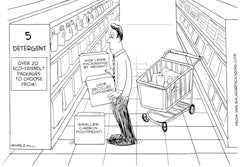The vast majority of the bottles are conventional monolayer PET. However a number of products have higher-barrier requirements than can be met by conventional monolayer PET. Such products include ketchup, some fruit juices, spaghetti sauce, and barbecue sauce, just to name a few. In this article we review a few of the technologies available for manufacturing high-barrier PET bottles. By no means is our review exhaustive in terms of covering all available technologies. But these are technologies that we find to be particularly interesting.
Going back a number of years ago, co-injection/stretch blow-molded PET bottles were a major technology used for high oxygen barrier, typically incorporating EVOH. Over the years there has been a trend away from co-injection/stretch blow-molded barrier bottles to other technologies. A major concern about co-injection/stretch blow molding were difficulties in commingling these barrier containers, which are made of multiple resins, with conventional PET bottles in the recycling stream. It’s possible for these multi-layer barrier bottles to contaminate the recycled PET resin and reduce overall clarity.
Monolayer PET barrier bottles
There has definitely been a trend toward increased use of monolayer PET barrier bottles, away from co-injection/stretch blow-molded and coated PET containers over the last few years. Nylon MXD6 emerged as a barrier resin that, when blended with PET, produced significant enhancements in oxygen barrier. MonOxbar® and Amosorb® are two technologies that are used in the US market commercially that do contain MXD6 nylon.
However, one of the problems that arises when using MXD6 nylon is that it tends to yellow the recycled PET material when mixed with conventional PET bottles. This is a major concern in the industry and there is significant interest in developing barrier containers that do not cause the recycled PET resin to yellow.
DiamondClear’ is a technology that was developed by Constar. It is a monolayer technology that blends in a proprietary barrier material with PET. DiamondClear containers can be mixed with conventional PET bottles in the recycling stream, as can other monolayer technologies. However, the real advantage of this technology is that it does not use Nylon MXD6 nylon (or for that matter any nylon) and that it reduces the yellowing that can occur when recycling it with conventional PET containers. ConAgra Foods converted its 46-oz plastic Hunt’s Kethcup bottle to Constar’s DiamondClear technology and won the 3M 2007 Sustainable Packaging Award at the AmeriStar competition. Constar is actively promoting this technology commercially.
"Nylon-free" technologies may be the wave of the future

























